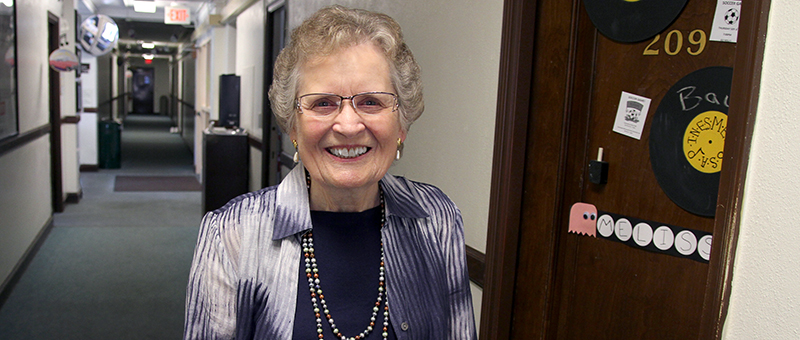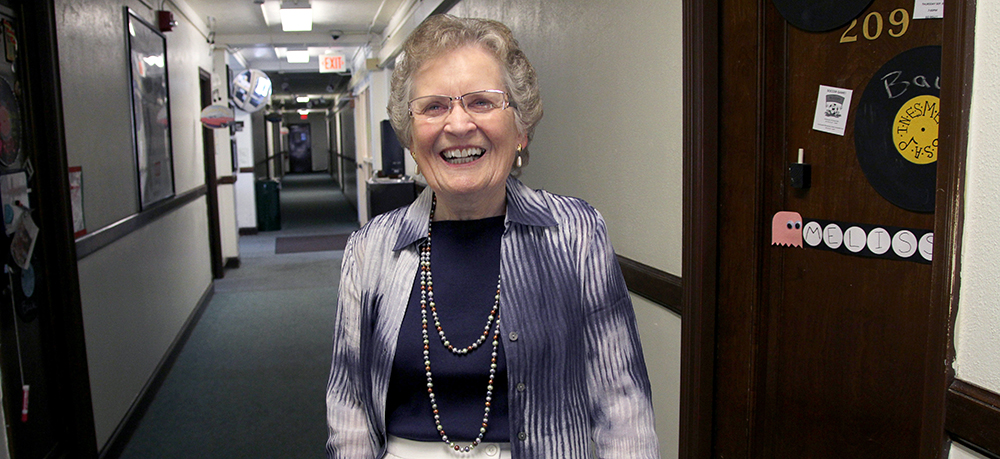Celebrating Women’s History Month: Garnet Cox

Minot State University is celebrating Women’s History Month throughout the month of March. MSU is recognizing the outstanding contributions women have made and continue to make at Minot State with stories gathered from the archive of our Alumni and Development Foundation magazine Connections. University Communications will highlight, and reprint it in its entirety, a story showcasing an individual who has made an impact at MSU, the greater Minot and Northwest North Dakota region, and on countless students’ lives.
This week, we are celebrating Garnet Cox. This 2013 article pretty much summed it up with its title as Garnet did a little bit of everything for our students including surrogate parent, mother superior, and frontier sheriff! She started at Minot State in 1963 as dean of women and remained at MSU for 33 years.
The article appeared in the Spring 2013 edition of Connections and its author is unknown. Check out our online ARCHIVE of Connections for more stories and features.
SURROGATE PARENT - MOTHER SUPERIOR - FRONTIER SHERIFF
Garnet Cox
Growing up in the bucolic village of Greene in upstate New York, Garnet Cox might have aspired to a career with IBM or one of the many defense firms located in nearby Binghamton. But no, she had a loftier goal.
“I wanted to see the world,” she said.
Her vision gave shape to a concrete strategy. After she graduated from the State University of New York at Brockport, she planned to see the country through a series of teaching stints at different colleges.
The stratagem worked quite well. She taught at a community college outside cosmopolitan Boston, at a private liberal arts college in Illinois and at prestigious Grinnell College in Iowa.
By 1963, Cox had earned a master’s degree in guidance and counseling from the University of Virginia. As she plotted her next adventure in academe, she faced a choice — the historic College of William and Mary in Williamsburg, Va., or Minot State College, a small school huddled on the snow-glazed Northern Plains.
Cox visited William and Mary, the second-oldest college in the country after Harvard University. Its colonial architecture, vast woodlands and man-made lake were appealing, but she chafed at the requirement that staff live on campus. Cox then turned to Minot State.
President Casper Lura and Herb Parker, the dean of men, interviewed her by phone. The two administrators weren’t disturbed by the young woman’s sojourning and offered her the position of dean of women.
Since the South was embroiled in the civil rights struggle at the time, Cox ruled out William and Mary and chose tranquil Minot State instead. She vowed to herself that she would stay just two years.
She remained for 33.
“I liked the people and the job,” she explained simply.

The three decades careened by quickly, a blur of daily routine, historic change, and oddball occurrences.
When Cox began, Minot State featured a student body of 1,600, traditional-age students, curfews for women, dress codes, Greek life and freshman initiation rituals.
When she retired in 1996 as dean of students, Minot State had 3,400 students, a large older-than-average contingent, coed residence halls, students with jobs and an extinct Greek culture.
When American campuses became restive during the Vietnam War in the late 1960s, Minot State President Gordon B. Olson drafted a one-page plan to forestall student riots. He assigned Cox and Parker to protect two key buildings. The deans decided, instead, to flank the bear-sized Olson if trouble broke out.
“If you stayed close to him, you were going to be safe,” she said.
No rioting ever occurred on the politically conservative campus. But Cox recalls the time a student tried to take down an American flag near Busse Fountain. When Olson heard about it, he bolted from his office to confront the offender.
“Do you have a problem with our flag?” the red-faced president thundered at the student.
“No,” the student said weakly.
“You’d better not,” said Olson, a World War II veteran of the South Pacific.
The student left quickly, and a small crowd melted away. Minot State’s involvement with the antiwar movement was over.
For 20 years, Cox teamed with Parker to police the campus and its residence halls. The pair vacuumed up some uncommon items over the years — a canon, raccoon, tree, bathtub filled with dirt, Saturday night specials, alcohol and drugs.
“We would have guns periodically, more during hunting season and with returning older students,” she said.
Alcohol abuse on campus was a perennial problem, and students found ingenious ways to imbibe. At one point, residents in one dorm complained that the elevator tended to stop from 4 to 5 p.m. each day. The residence hall staff investigated and quickly solved the mystery.
“Students were having cocktail hour on the elevator,” Cox said. “They didn’t want to get caught with alcohol in their rooms.”

Cox experienced a spectrum of human emotions during her tenure. She dealt with students’ academic setbacks and triumphs, their personal problems, and their family tragedies. She witnessed campus events as disparate as a student’s wedding and a faculty member’s funeral.
Her favorite time period was the 1960s and ’70s, when campus groups and Greek organizations created a lively environment.
“It was a fun, energetic time,” she said.
Through three decades, Cox was a ubiquitous presence on campus, a thin sliver of a woman who met the world with a perpetual smile and a hearty laugh.
When Minot State took a chance on the academic nomad in the early 1960s, it unwittingly secured a multitalented administrator — surrogate parent, mother superior and frontier sheriff — all for the price of two phone calls.
SIDEBAR STORY: Minot State through the decades
In 1963, each residence hall floor had one payphone. Dakota Hall had a buzzer system with each person having her own code. When phones were installed in rooms, the telephone booths were converted to hold microwaves, because students were not allowed to cook in their rooms.
Cook Hall construction was delayed in 1965-66. The fifth floor was completed first, therefore, student occupation occurred from the top down.
The ’70s brought students increased personal freedom. Many had cars. Women especially had more academic and career choices.
In 1980, MSC experienced an increase of 600 students from the prior fall to hit a milestone enrollment of 3,000. Many students were “older than average.” Enrollments continued to climb until 1993, when MSU’s top enrollment of 4,047 was reached.
Despite all the changes, Cox knows she made the right decision coming to MSU and staying in Minot.
“I had so many good experiences, so I made this my permanent home. It’s the people, and it’s just a good place to live,” Cox said.
About Minot State University
Minot State University is a public university dedicated to excellence in education, scholarship, and community engagement achieved through
rigorous academic experiences, active learning environments, commitment to public service, and a vibrant campus life.
Published: 03/10/23



